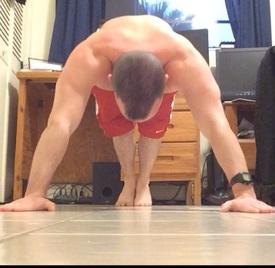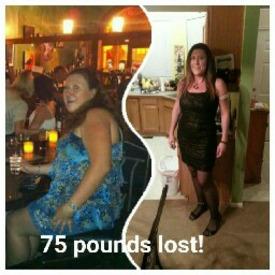High reps low weight or low reps high weight?

kjg1965297
Posts: 121 Member
This seems to a issue that I have not heard a lot on. I have lost 55 lbs but I want to make sure I don't end up a thin fat person. I have a full gym available 5 days a week and am struggling what to do. I know most of the exercises that I need to do to target different groups of muscles. I am currently lifting low with lots of reps (15). I am not really wanting to build a pile of muscle but I would like to look toned and strong. Help!!!!!!!!!!!!!!!!!!!
0
Replies
-
The best answer is both. I like to cycle through them with four weeks heavy, four weeks light. Do compound movements (not single joint exercises). You'll find you get a different kind of feeling from them and should slowly progress in weights (even the low weights should show progression). Enjoy!0
-
Reader's digest version: There are different kinds of muscle fibers and physioloical processes that contribute to muscle growth and density.
The 3-5 rep range is best for training for strength but with slower muscle growth, relative to the 8-12 rep range where you will see more growth but less strength.
Like the poster before said, doing both is best. Since you're a beginner, you should get on a program so you don't have to guess at this stuff. Stronglifts 5x5 is as simple and fundamental as it gets, and it's good for building up your strength (Step 1 for a beginner).
Once you stall on that program, you should consider Wendler's 5/3/1 which keeps going with heavy lifts, but also incorporates higher rep "assistance work".
For general good info about the benefits of lifting, consider "New Rules of Lifting". Easy to read, and again, focused on fundamental information.0 -
To build muscle (women can't bulk up like men) you have to work until muscle fatigue. You need a weight that feels comfortable for the first few reps, and the last few reps you struggle a bit without compromising form. I love lifting and seeing the almost immediate results that lifting gives me.0
-
You are not going to build muscle on a calorie deficit. You have to eat at a big calorie surplus and workout pretty heavily to gain lean body mass (muscle).
It seems like you are more interested in preserving the LBM you already while continuing to lose fat. A simple compound routine will achieve that for you. Do you have access to a squat rack, benches, barbells, and free weights ? I would suggest looking into Stronglifts 5x5 or Starting Strength. Both are proven routines that build strength while burning fat.0 -
15 reps is basically the muscular endurance range...I'd personally prefer to just do some circuit training/crossfit/etc and get more bang for my buck than hitting the weight room and working in that kind of rep range. That said, I do some assistance work in that rep range for the purpose of muscular endurance...but my primary lifts are either in the 1-3-5 rep range for strength and 8-12 for hypertrophy/mass.
I'm a very strong proponent of building a strong foundation of functional strength first and foremost...look to programs like Starting Strength and Strong Lifts 5x5. Once this has been established there are numerous directions you can take in RE to your weight training...Oly-Lifting, Power-Lifting, Body Building, etc. Having a strong foundation and a lot of exposure to the fundamental compound lifts will go a long way in making you a better lifter no matter which way you ultimately go.
I do think things like circuit training and muscular endurance training have a lot of value...but IMHO, they should be a part of your routine, but not necessarily BE your routine.0 -
To build muscle (women can't bulk up like men) you have to work until muscle fatigue. You need a weight that feels comfortable for the first few reps, and the last few reps you struggle a bit without compromising form. I love lifting and seeing the almost immediate results that lifting gives me.
Right exactly.
Caveat: muscle fatigue, not to be confused with muscle failure.0 -
for muscle retention while dieting: low reps, high weight. keep your strength and you will keep most of your lean mass.
for building lean mass: a combination of both. (compounds with low reps and hight weight supplemented with higher rep assistant work)
15 rep set only workout rarely make sense. thats basically endurance.0 -
There is good advice here, but not specific to your age or health, more for the 20 to 30 yo crowd.
I would suggest you stay in the 10 to 15 rep range, and lift no more than 3 times per week, with light cardio for off days.
#1 your body's recovery ability is limited by your health issues.
#2 you are almost 50, and your ligaments won't tolerate the low rep high weight style for very long before injuries start.
#3 stick with 2 to 3 full body work outs per week, it is simple efficient and effective.0 -
http://www.bodyrecomposition.com/training/weight-training-for-fat-loss-part-1.html
In case you don't want to read it, it says that the same type of lifting that is done to build strength (2-6 reps) is what is best at preserving muscle (which is what we want when we diet and lift).0 -
Yes. As others have said your program will be based on your particular experience and needs but here is some info on the subject from a solid source.
From Brad Shoenfeld
http://www.t-nation.com/training/light-weights-for-big-gains/printMultiple Rep Ranges Means Maximal Stimulation
For those who want to maximize their hypertrophic potential, it makes sense to train across the continuum of repetition ranges. While there may be validity to focusing on the so-called "hypertrophy range" (6-12 reps), both high (15-20+) and low (1-5) repetition ranges should also be incorporated into your training program.
Not only does such an approach ensure full stimulation of the spectrum of muscle fibers, but it also serves as preparatory work for optimizing performance in the hypertrophy range. Low rep work enhances neuromuscular adaptations necessary for the development of maximal strength so that heavier loads (and thereby greater mechanical tension) can be used at moderate training intensities.
Conversely, performance of higher-rep sets help over time to raise lactate threshold, staving off the onset of fatigue and thus increasing time-under-tension during moderate-rep training.
There are infinite ways in which varied intensities can be integrated into program design. Perhaps the best way to ensure continued progress is by periodizing training rep ranges over time. Both linear and non-linear models are viable alternatives here. It really comes down to personal preference as well as individual goals (i.e., whether you're looking to peak for a specific event).
Another option is to base loading strategies on the type of exercise performed. You might decide to focus on low to moderate-reps (~1-10) for multi-joint movements such as squats, rows, and presses while prioritizing higher rep training (15+) for single-joint, isolation type exercises that may be better suited to lighter training loads.
There are no hard-and-fast rules here. The response to training varies by the individual and ultimately you need to experiment with different approaches and find out what works best.
ETA: The whole article is good. I just quoted one section of it.0 -
There are other benefits to lifting than just building or retaining muscle.
Heavy lifting is great for improving bone density, joint health and making you stronger.0 -
The trainer I went to said to alternate between targeted and full body workouts.2-3 per week of each. She said cardio if you want to, but unnecessary. of course she was giving me advice based on my personal goals and my fitness level. so that's what i am doing now. And i'm loving it. plus I do ridiculous cardio.. cause I love it. lol You might benefit by talking to one yourself. Just go in with specific goals and tell them if you have limitations or already do certain exercises. Mine called me before our first appointment in order to find out what I was looking for out of the gym so she could tailor the workout to me.
ps.. a lot of gym memberships offer 1 free trainer appointment per year.. so if you haven't used yours.. do it.0 -
As someone else has said get the new rules of lifting book.
I do 12 weeks of low rep (3-5), high weight sets, increasing weight with compound movement training (more of the 5x5 training program) then i will switch to 8-10 rep range with medium to heavy weight for the next 10-12 weeks.
It really depends on goals though. For me I like to lift heavier to build up my overall muscle mass then do more higher rep training after 3 months to cut a bit.0 -
The trainer that i work out with (has been body building for 25 years) has me on a work out routine that is typically 3 sets of 12-15 reps of low weight increasing weight when required which has worked very well for me so far. Super sets are included on some exercises as well.
I am not trying to bulk up or get incredibly cut, as an equestrian we use our muscles in a different way than the average person would. Im being trained more or less the same way a Jockey would train....
Regardless i think that taking peoples advise online (yes some of it may be really good advise) probably isnt the best idea....0
This discussion has been closed.
Categories
- All Categories
- 1.4M Health, Wellness and Goals
- 398.2K Introduce Yourself
- 44.7K Getting Started
- 261K Health and Weight Loss
- 176.4K Food and Nutrition
- 47.7K Recipes
- 233K Fitness and Exercise
- 462 Sleep, Mindfulness and Overall Wellness
- 6.5K Goal: Maintaining Weight
- 8.7K Goal: Gaining Weight and Body Building
- 153.5K Motivation and Support
- 8.4K Challenges
- 1.4K Debate Club
- 96.5K Chit-Chat
- 2.6K Fun and Games
- 4.8K MyFitnessPal Information
- 12 News and Announcements
- 21 MyFitnessPal Academy
- 1.5K Feature Suggestions and Ideas
- 3.2K MyFitnessPal Tech Support Questions











